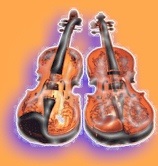 Again featuring Lee MacKenzie on cello, double bassist John Parker and both producer Mark Tucker and Evan Carson on percussion, close harmony duo Jon Whitley and Jay LaBouchardiere’s fifth album, The Colour Of Night, their first new material in over two years, brings together a mix of originals, covers, the traditional and a setting of a poem by the Dorset dialect poet William Barnes, who inspired many of the lyrics on the previous album.
Again featuring Lee MacKenzie on cello, double bassist John Parker and both producer Mark Tucker and Evan Carson on percussion, close harmony duo Jon Whitley and Jay LaBouchardiere’s fifth album, The Colour Of Night, their first new material in over two years, brings together a mix of originals, covers, the traditional and a setting of a poem by the Dorset dialect poet William Barnes, who inspired many of the lyrics on the previous album.
Crafting a nocturnal mood reflecting the album title, they kick off with a cello and piano-based arrangement of Patrick Wolf’s ‘House’, a number which, referencing Dylan Thomas, Yeats and Thomas Hardy, he wrote as a celebration of home and belonging, the duo embracing it as a lockdown anthem. Coincidentally perhaps, the first of the self-penned tracks is ‘Names In The Sky’, inspired by a Radio 4 programme of the same name about a South Wales children’s hospice called Ty Hafan, which translates as House Of Hope. The five-minute song, again anchored by cello and opening with harmonium and a fittingly elegiac, dreamlike ambience, relates the story of sound artist Justin Wiggin who created a sonic garden to commemorate the children who had passed on, fusing local birdsong with a Morse code algorithm to have the names of the children ‘sung’ from the speakers, translated into the lyrics as “I’ll sing as I build for my children a nest/Oh I’ll sing them the songs that lie deep in my breast” as they take to the sky.
The lyric mentions a blackbird and ‘Among The Boughs’ is their heavily adapted setting (no dialect) of Barnes’s poem ‘The Blackbird’, a churchy harmonium underpinned, musically sprightly celebration of the coming of spring. Sandwiched between with LaBouchardiere singing lead, the wistful ‘Walk With Me’ is built around piano arpeggios, cello and bass joining later, and inspired by their partnership, both personal and professional, and countryside rambles is, as he puts it, “an ode to sharing some time – an hour or a few decades – with someone who makes your life better just by being there”, or as the lyrics ask, “I could walk alone, but would you walk with me?”
Moving from spring to summer, drawing on their Dorset roots, ‘Cast To The Waves’, with its natural world imagery of birds, butterflies and flower, warm lilting picked guitar-led melody and their Simon & Garfunkel-like harmonies, relates to an old May Day tradition in the village of Abbotsbury wherein the children make two floral garlands (one each of garden and wild flowers) which are then paraded before being cast into the sea as an offering to ensure good fishing.
The sole instrumental, etched on Whitley’s classical keyboards, the meditative ‘Kitty’s Tune’ was commissioned by the Off The Map theatre company for a production based around South West folklore, one being the legend of Kitty Jay, a housemaid who, straying from the path through her desire to explore the world beyond her community, committed suicide after being ostracised for becoming pregnant out of wedlock and who is buried on Dartmoor. That segues into the album’s traditional component and their stripped back interpretation of ‘The Snows They Melt The Soonest’, taking their influence from the version by Dick Gaughan.
The second cover is their reading of ‘Ride On’, written by Jimmy MacCarthy and made famous by Christy Moore, though here taken at a slower, more melancholic pace with piano backing the vocals as it build to embrace swirling cello and bass. The two remaining originals line up back to back, the first, Carson’s percussion in the spotlight, ‘Ten Miles By Two’ returning to local matters with a number rooted in the county’s quarrying history, reed organ and strings building the muscular intensity and taking its title from the area in which the prized Purbeck marble (a form of limestone used in building St Paul’s Cathedral) was found and the 1904 incident when the quarrymen broke through the barriers erected by the local landowner (who could level a toll on any stone removed) to stop them exercising their right to dig, Listening, it’s hard not to draw comparisons with Seth Lakeman, minus the fiddle.
Local colour also informs the harmonium-shaded, atmospheric hymnal-like title track, written by LaBouchardiere about night in Ninebarrow Woodland and, more especially, how the anxiety-inducing eeriness as he stood there, calming himself by imagining it in sunlight, the words set to an old Icelandic folk tune ‘Vökuró’ (itself recorded by Bjork), the poetic lyrics about metaphorically looking for the light in times of darkness.
They end with the final cover, a contemplative piano-based homage reworking of Nick Drake’s enigmatic time-signature challenging ‘River Man’, closing on a single suspended piano note. Released, as ever, with an accompanying full colour booklet of illustrations, annotations and lyrics, perfectly capturing the stillness of the world evoked by the title alongside the energy of daylight hours, and the often unobserved magic of the two, The Colour Of Night is an intoxicating triumphant way to mark their first ten years and a tantalising suggestion of what yet lies ahead.
Mike Davies
Artists’ website: www.ninebarrow.co.uk
A snippet of ‘Ride On’ – all they have given us:
 Thanks for stopping by. Please help us continue and support us by tipping/donating to folking.com via
Thanks for stopping by. Please help us continue and support us by tipping/donating to folking.com via
You must be logged in to post a comment.